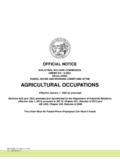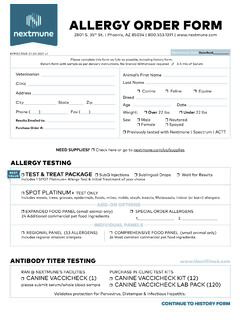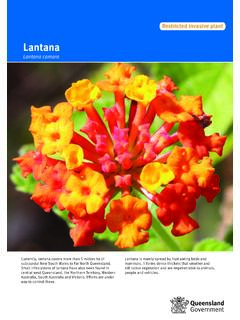Transcription of Lumpy Skin Disease (LSD) field manual
1 ISSN 1810-1119. 20. FAO animal PRODUCTION AND HEALTH. manual Lumpy SKIN Disease . A field manual for veterinarians Cover photographs left to right: Left: FAO/Eran Raizman. Middle: National Food Agency, Georgia. Right: FAO/Attila Kisbenedek. 20. FAO animal PRODUCTION AND HEALTH. manual Lumpy SKIN Disease . A field manual for veterinarians Authors Eeva Tuppurainen Independent consultant Tsviatko Alexandrov Bulgarian Food Safety Authority (BFSA). Daniel Beltr n-Alcrudo FAO. FOOD AND AGRICULTURE ORGANIZATION OF THE UNITED NATIONS. Rome, 2017. Recommended Citation Tuppurainen, E., Alexandrov, T. & Beltr n-Alcrudo, D. 2017. Lumpy skin Disease field manual . A manual for veterinarians.
2 FAO animal Production and Health manual No. 20. Rome. Food and Agriculture Organization of the United Nations (FAO). 60 pages. The designations employed and the presentation of material in this information product do not imply the expression of any opinion whatsoever on the part of the Food and Agriculture Organization of the United Nations (FAO) concerning the legal or development status of any country, territory, city or area or of its authorities, or concerning the delimitation of its frontiers or boundaries. The mention of specific companies or products of manufacturers, whether or not these have been patented, does not imply that these have been endorsed or recommended by FAO in preference to others of a similar nature that are not mentioned.
3 The views expressed in this information product are those of the author(s) and do not necessarily reflect the views or policies of FAO. ISBN 978-92-5-109776-2. FAO, 2017. FAO encourages the use, reproduction and dissemination of material in this information product. Except where otherwise indicated, material may be copied, downloaded and printed for private study, research and teaching purposes, or for use in non-commercial products or services, provided that appropriate acknowledgement of FAO as the source and copyright holder is given and that FAO's endorsement of users' views, products or services is not implied in any way. All requests for translation and adaptation rights, and for resale and other commercial use rights should be made via or addressed to FAO information products are available on the FAO website ( ) and can be purchased through iii Contents Foreword v Acronyms vii Introduction 1.
4 Epidemiology 3. Causative agent 3. Geographic distribution 3. Susceptible hosts 4. Transmission 5. Clinical signs of Lumpy skin Disease and postmortem findings 7. Differential diagnosis 15. Measures on the farm when Disease suspected 21. How to conduct an outbreak investigation 22. Sample collection 25. Preferred sample types 25. General rules 25. Transport of samples nationally and internationally 29. Dispatch and storage of samples during transport 29. Laboratory confirmation of suspected cases and available diagnostic tools 33. Virus detection 33. Detection of antibodies 34. Role of the national reference laboratory 34. International reference laboratories (contact points and information) 35.
5 Control and prevention of Lumpy skin Disease 37. Prevention of Lumpy skin Disease 37. Currently available vaccines, selection of an effective vaccine, 37. adverse reactions and vaccination strategy Cattle movement controls 40. Stamping-out policies and disposal of carcasses 40. Cleaning and disinfection of personnel, premises and the environment 42. insect control on animals and in the environment 42. Biosecurity measures at holdings 43. Target audience for awareness campaigns 43. Surveillance programmes 43. References 45. iv LIST OF FIGURES. 1 Countries that have reported LSD 4. 2 Schematic illustration of the spread of LSDV 5. 3 Some airborne LSDV vectors 6.
6 4 South African Bont Ticks (Amblyomma hebraeum) feeding 5. 5 Mild case of LSD showing characteristic skin lesions (full body) 8. 6 Mild case of LSD showing characteristic skin lesions (neck) 8. 7 Severely affected cow with multiple skin lesions 9. 8 Severely affected cow with skin lesions covering the entire body, and enlarged lymph node 9. 9 Skin lesions in the perineum and genitalia 10. 10 Severe form of LSD with skin lesions in the head, neck, limbs and entire body 10. 11 Conjunctivitis and nodular skin lesions on the head 11. 12 Ulcerative lesions in the muzzle and lips 11. 13 Ulcerative skin lesion before scab formation 12. 14 Severe case of LSD with skin nodules covering the udder and teats 12.
7 15 Ulcerative lesion in the teat 13. 16 Skin lesion with a scab attracting domestic flies 13. 17 Skin lesions with scabs, ulcers and scars 14. 18 Internal LSD lesions 14. 19 Bovine Herpesvirus 2 16. 20 Pruriginous urticaria 16. 21 Pseudocowpox lesions on the teats 17. 22 Ringworm 17. 23 Demodicosis skin lesions 18. 24 Papular stomatitis 18. 25 Besnoitiosis 19. 26 Onchocerciasis lesions on the ventrum 19. 27 Clinical examination 22. 28 Collection of saliva for PCR testing during an outbreak in Bulgaria 27. 29 Scabs are excellent sample material. Scab coming off leaves a raw ulcer 28. 30 Collection of blood samples from the tail vein in vacutainer EDTA for PCR testing 28.
8 31 Labels used for international transfer of infectious substances 31. 32 Local reaction at vaccination site 38. 33 Post-vaccination superficial generalized skin lesions 39. 34 Post-vaccination superficial skin lesions in the udder 39. 35 Burial of carcasses 41. 36 Disinfection operations following an LSD outbreak 42. v Foreword Lumpy skin Disease (LSD) was for long restricted to sub-Saharan Africa. However, over the past decades it has slowly invaded new territories, sweeping first into the Middle East and Turkey, and, since 2015, into most of the Balkan countries, the Caucasus, and the Russian Federation, where the Disease continues to spread despite implemented prevention and control efforts.
9 The Disease is having dra- matic effects on rural livelihoods, which are strongly dependent on cattle, with significant income losses for affected farmers. Consequences are also devastating at national level since the presence of the Disease has triggered strict trade restric- tions. The risk of imminent contagion of neighbouring countries is very high. In the current situation, veterinary services from affected and at-risk countries in the Middle East and Europe are confronting the Disease for first time. Official veterinarians, cattle farmers and others along the value chain are therefore unfa- miliar with the Disease 's clinical presentation, its transmission routes, and available prevention and control options.
10 This manual is aimed at filling these gaps, princi- pally with regard to the first line of defence, those working in the field , who are most likely to encounter the Disease . The authors would like to express their sincere thanks to the global sci- entific community contributing to LSD research, as well as to international organizations working in this field , such as the World Organisation for animal Health (OIE), the European Commission and the Directorate-General for Health and Food Safety (DG SANTE), the European Food Safety Authority (EFSA), the European Commission for the Control of Foot-and-Mouth Disease (EuFMD), the International Atomic Energy Agency (IAEA) and national and international refer- ence laboratories.













